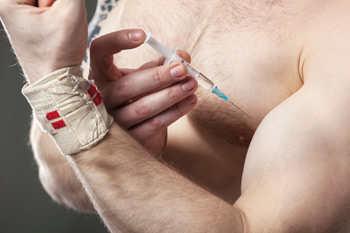Even some Olympic athletes cheat with drugs
As new ways of doping emerge, scientists develop ways to catch the cheaters

Athletes train to get stronger, run faster and jump higher. But some may turn to an illegal short-cut: performance-enhancing drugs. Scientists are working to find these cheaters.
Jacob Ammentorp Lund/istockphoto
MANCHESTER, England — Keen viewers of the Rio Olympics this week may notice that one country’s team is a lot smaller than usual. Russia brought only about 70 percent of the athletes it had expected would compete. Some 30 percent — including all weightlifters and all but one track and field athletes — were banned from the competition. The reason? They were caught up in a cheating scandal.
The type of cheating these athletes had participated in is known as “doping.” It involves the use of drugs to improve performance. These drugs have medical purposes for people who are ill. But in healthy athletes, they can provide an illegal advantage by boosting muscle growth or offering other benefits.

And it’s not just using these substances that can get an athlete in trouble. Athletes also can get banned for refusing to participate in (or tampering with) efforts to find others who use doping drugs. The Russian scandal involved an elaborate plot to interfere with these tests.
But as people have developed new ways to dope, so have scientists worked on ways to find them.
Malene Lindholm studies how genes affect people’s athletic abilities. A scientist at the Karolinska Institute in Stockholm, Sweden, she spoke here on July 26 at the EuroScience Open Forum. “Doping is a constant battle,” she warns, “especially in elite sports.”
A long history of doping in sports
Athletes have been trying to improve their performance with various substances since at least the time of the ancient Greeks. That’s more than 2,000 years ago. Back then, athletes took substances such as strychnine (STRIK-nyne), a poison, to run faster and fight better.
The modern era of doping, though, began in the middle of the 20th century. That’s when some athletes began taking drugs called amphetamines (Am-FET-uh-meens). Soldiers in World War II took such drugs to overcome fatigue. They seemed to help athletes, too.
During that time, athletes also began taking anabolic steroids. These drugs mimic the human hormone testosterone (Tes-TOS-tur-ohn). In medicine, these drugs can offer useful benefits, such as stimulating appetite or regaining lost muscle. But healthy athletes figured out that they could also use the drugs to get bigger and stronger.
Such drug use can have deadly consequences, though. On August 26, 1960, Danish cyclist Knud Jensen died while competing at the Olympics in Rome, Italy. During his team’s 100-kilometer (62-mile) time-trial race, he collapsed. During the fall he hit his head, fracturing his skull. An autopsy found traces of an amphetamine in his blood.
Afterward, Olympic officials began regularly testing athletes for banned drugs. That didn’t stop people from doping. It did, however, make it a lot harder for them to get away with it. As new drugs and ways of doping emerged, officials banned these, too. And with each new development, scientists have figured out ways to scout out signs that an athlete has used these doping substances.

Arne Ljungqvist is a researcher in medicine and sports. He has spent decades on antidoping studies and today heads a private antidoping group in Sweden. Ljungqvist sees this work as a personal quest to keep Olympians honest. A former Olympian, he was a high jumper in the 1952 games in Helsinki, Finland. “Science has been used for the purpose of combating the evil of doping in sport,” he says. “And it seems in vain. But I can tell you it’s harder now than it used to be” to dope in sports.
Antidoping officials can even catch people who doped years ago. Because blood samples are kept for years after an athlete competes, scientists can go back and test them when new methods emerge. Within the last year, for instance, officials went back and tested samples from the last two summer Olympics. These were the 2012 games in London, England, and the 2008 Olympics in Beijing, China. The new tests turned up evidence of doping among some athletes who originally had been deemed “clean” of drugs. Those athletes are now being disciplined. Some have had had to return their medals.
New methods of doping
At this year’s Olympics in Rio de Janeiro, Brazil, antidoping efforts have already caught three athletes. Their blood tests revealed that they had used banned or controlled substances. These athletes have now been expelled or suspended from this year’s games.
But testing will not end when the 2016 games do. Some of the athletes’ blood samples will be held for testing later. Scientists will be looking for signs of a new type of cheating: gene doping.

Carl Johan Sundberg studies human genetics and physical activity at the Karolinska Institute. “Gene doping mimics, or basically copies, what is done with gene therapy,” he explains. It starts with a vector. This is the term biologists give to something that serves as a carrier. It could carry a disease or even something as small as a gene. In gene therapy, scientists typically use a virus as a vector to insert a gene into a patient. This is usually done to treat a genetic disease.
But researchers suspect that some unethical scientists may be helping athletes cheat. Those scientists may be using the new technology to insert genes that could give those athletes a competitive advantage in their sport.
“We do not know whether it has been conducted or not,” Sundberg says of gene doping. But scientists in Australia figured out a way to detect if an athlete is gene doping. So now officials are hoping to use that test on an Olympian’s blood in the near future.
They’ll be looking for signs of a gene inserted to help the body make more of a protein called EPO. It’s short for erythropoietin (Eh-REETH-roh-POY-eh-tun). This is the substance that famed Tours de France winner Lance Armstrong was caught using before he was banned from the sport of cycling (and stripped of his seven wins). EPO injections will boost the body’s production of red blood cells. That can improve the amount of oxygen that can be delivered to cells. The end result can be an improved fitness and endurance.
The new test will scan for two things. One is the virus used to ferry the EPO gene into an athlete’s body. And the other is the EPO gene itself. A person’s own EPO gene has introns. These are extra bits of DNA that are cut out when a cell translates a gene to make the EPO protein. But an inserted gene would likely lack those introns. So their absence could signal gene doping.

Doping is frowned upon because it is cheating. And to Mike McNamee, “It all comes back to the question of why we value sports.”
McNamee studies sports ethics at Swansea University in Wales. To create a sport, “we design rules in order to make simple activities really difficult,” he says. Swimming in a pool isn’t that hard, for instance. But the rules of swimming as a sport limit the kinds of arm movement or kicking style a person can use. Such rules turn the activity into a sport. Using substances to overcome some of those difficulties makes such competitions pointless, he argues.
But doping is also a matter of health and safety. Gene doping also could bring great risks, says Sundberg. Inserting a gene might cause cancer. Or it might trigger a deadly reaction by the body’s immune system. It might even thicken the blood to the point that an athlete risks developing a stroke. “And because you have introduced the material and cannot retract it,” he says, “you’re stuck with it.”
Sundberg worries that other technologies being developed could be used in similar ways, with their own risks. Cell therapy — such as bone marrow or skin transplants — have helped many people. But it could be used for doping purposes, too, in hopes of making muscle or the heart stronger, he says.
Researchers are also developing gene-editing treatments that use a technology called CRISPR-Cas9. It’s still early days in CRISPR studies. Researchers are looking at how to make it safe and effective. But in time, it “may be used in doping as well,” Sundberg says. “This is a bit of science fiction — but not really.”
Doping outside of sports
Athletes aren’t the only people doping. “We face another danger,” worries Ljungqvist: “the use of doping substances by mainly young people.” He argues that “this is a rising public health issue around the world.”

No one knows how many non-athletes are using medicines in this way. It is thought that it is mostly teenage boys “who want to be bigger and stronger — ripped and looking like their favorite Hollywood actor,” says McNamee. “But it’s also policemen, firefighters, security guards, bouncers on the doors.” There may be lots of other groups, as well, that have their own reasons for abusing substances in a way similar to that of elite athletes, he says.
Such doping brings real dangers. Studies and investigations have repeatedly shown that some food-supplement makers have sold products with hidden ingredients. These range from illegal drugs to chemicals that have never been tested in people. And these supplements can make people ill. One study published last year, for instance, found that each year supplements send thousands of people, including many teens, to U.S. hospitals.
Simply outlawing all use of doping substances won’t work, says McNamee. That’s because many of them have valid uses.







